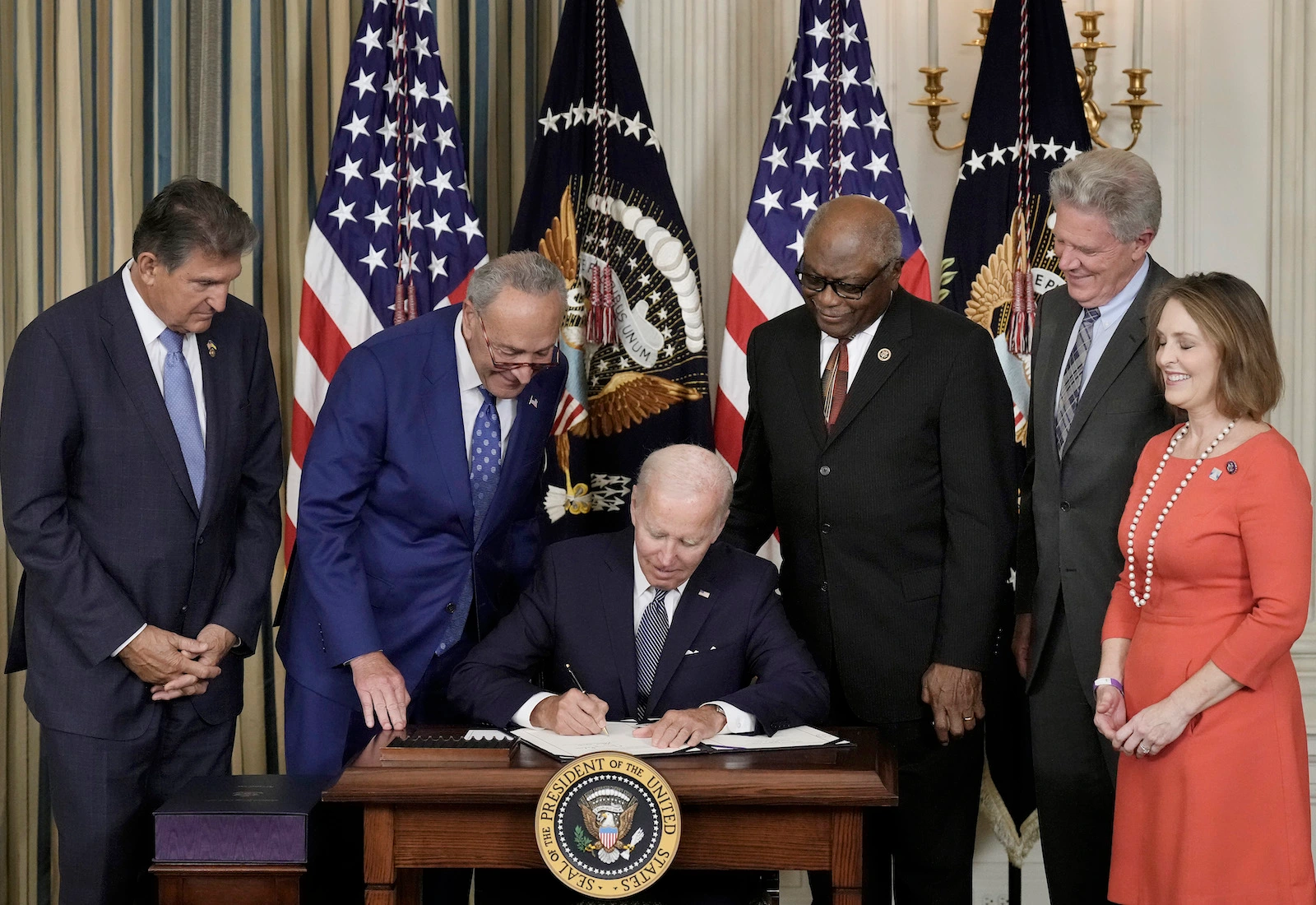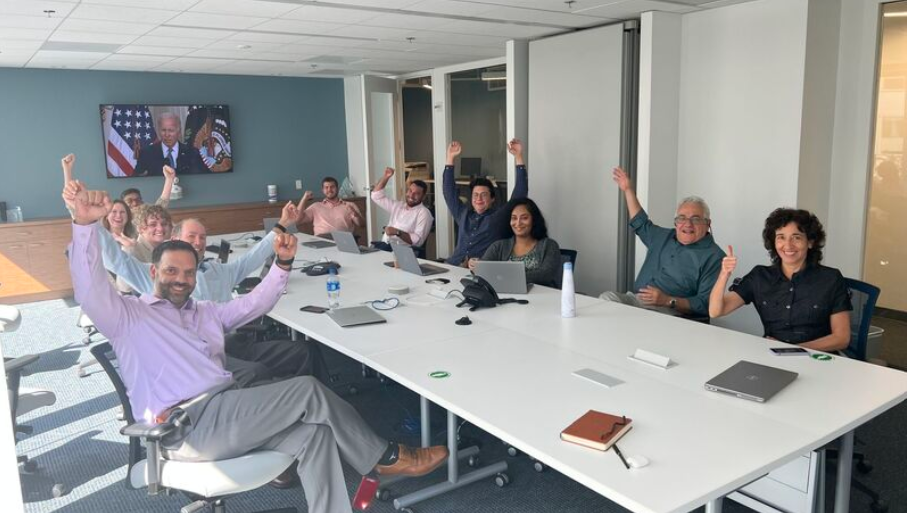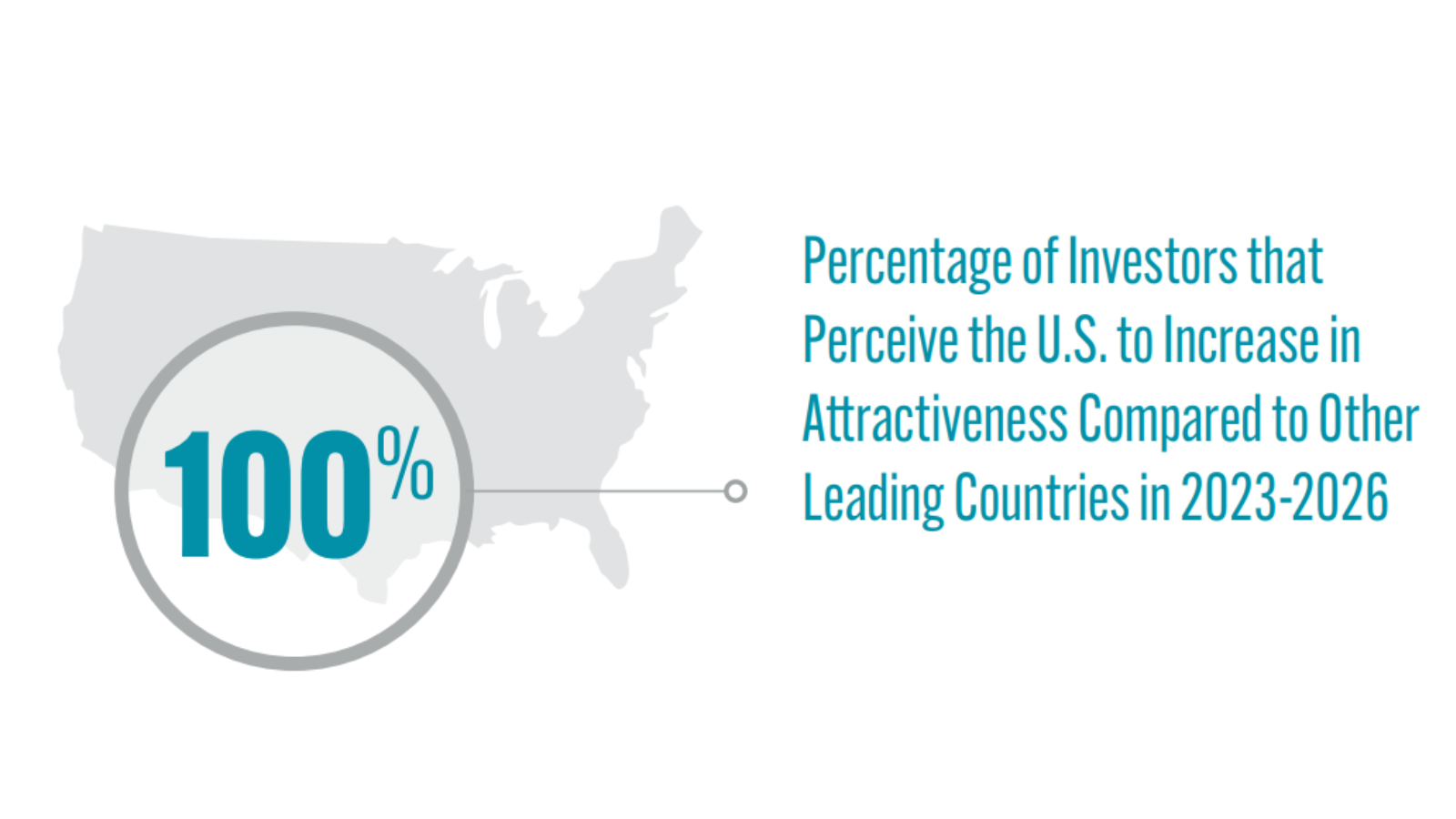- Just Transition
- Project Finance
- Renewable Energy Innovation
- Supply Chain & Trade
- Tax Incentives & Appropriations
- Transmission & Power Markets
- Blog
Celebrating One Year of Progress: The Inflation Reduction Act’s Impact on Renewable Energy and the American Economy
This week, we commemorate the one-year anniversary of President Joe Biden’s signing of the Inflation Reduction Act (IRA)— landmark legislation that is accelerating the renewable energy transition consistent with the climate imperative. As we celebrate this milestone, we reflect on the law’s transformative benefits, and the role that ACORE and its engaged members played in its enactment and ongoing implementation.
Updating the Tax Code to Meet the Challenges of the 21st Century
For more than a century, our nation’s tax code has been weighted to incentivize fossil fuels. The IRA finally moved the country beyond years of on-again, off-again renewable tax credits to long-term, full-value incentives, providing the renewable sector with the crucial policy stability that all businesses seek and competing energy sectors have long enjoyed.

Credits for renewable generation were complemented by incentives for free-standing energy storage, domestic clean energy manufacturing, and new technologies like clean hydrogen. Also included were impactful incentives to promote a more equitable energy transition through credit bonuses that reward development in low-income communities and fossil infrastructure areas with high unemployment levels. Additionally, Congress directly addressed concerns about tax equity supply by providing direct pay in specified circumstances, while otherwise making renewable tax credits broadly transferable.
At long last, we have a 21st century tax code that supports the clean energy transition.
ACORE’s Role
The journey to the IRA’s enactment was marked by collaboration, broad engagement, and strategic advocacy, and I’m proud of the role that ACORE played. For ACORE, the IRA represented the culmination of years of determined efforts to move the renewable sector past the vagaries of short-term extensions and embrace a broader, long-term agenda that incentivizes crucial grid technologies, like energy storage, and supports the expansion and modernization of the nation’s grid.

A key turning point came in late 2017 when ACORE, engaged member companies, and sector allies successfully battled arcane tax law assaults buried in the “Tax Cut and Jobs Act” that would have undermined the economics of both new and already operating power plants. In the years since, we published a broad array of reports, policy analyses and formal filings to support our agenda and accelerate the energy transition. With help and participation from diverse member companies, we undertook hundreds of meetings with key players on Capitol Hill and beyond. Even as we endured more than a few disappointments, we made a special effort to work collaboratively and expand our spectrum of allies, and the renewable community persevered.
Realizing the Benefits
With a year under our belt, we can say with confidence that the law is working to accelerate the nation’s energy transition, spur national economic growth, and launch a renaissance in American manufacturing. Hundreds of billions of dollars have been committed to new clean energy investments over the past year. This investment will lead to dozens of new manufacturing facilities across the U.S., thousands of megawatts of additional wind and solar power capacity, hundreds of thousands of good-paying jobs, significant cost savings for American electricity consumers, cleaner air, and progress toward a more stable climate.

ACORE’s recent Expectations for Renewable Energy Finance report, which presents the results of a survey of the sector’s leading investors and developers, highlights several key trends that demonstrate the IRA’s far-reaching impact:
1. Increased Investment and Deployment
The renewable energy sector is experiencing an unprecedented surge in activity. All surveyed developers and a significant majority of investors intend to intensify their engagement in the U.S. renewable energy industry compared to previous years. In fact, 84% of investors are planning to increase their U.S. renewable energy investment by 5% or more this year.
For the first time in the six years ACORE has conducted investor surveys, investors unanimously expect the United States to increase in attractiveness for renewable energy investments compared to other countries. The global attractiveness of the U.S. market is expected to further accelerate growth and again cement the role of the U.S. as a world leader driving the clean energy transition.
2. Meeting Heightened Demand for Tax Equity
The tax equity market must undergo substantial growth to match the heightened demand brought about by the new law. Survey participants recognize this necessity, acknowledging that the market’s size must nearly triple from its current range of $20 billion annually to exceed $50 billion. This growth is crucial for meeting the rising demand for project finance as renewable energy projects proliferate. Unfortunately, even as the focus has been on expanding the marketplace, ACORE and leading investors are today assessing proposed new international banking regulations that would impose new capital requirements, and possible top-up taxes by OECD countries, likely to constrain tax equity investment.
3. Embracing New Financing Mechanisms
The IRA’s transferability and direct pay provisions are emerging as vital tools for renewable project finance. More than 80% of surveyed investors expect to utilize these provisions. The flexibility and efficiency offered by these mechanisms are expected to reshape the investment landscape for renewable project development.
4. A Renaissance in Domestic Manufacturing
The IRA has prompted a surge in domestic clean energy manufacturing efforts. More than one-third of investors (38%) plan to invest in domestic clean energy manufacturing facilities in the U.S. Twenty-eight percent of developers report plans to open a new manufacturing plant, and 33% plan to incentivize their suppliers to open domestic facilities.
5. Focusing on Communities
Over 90% of surveyed investors and developers report plans to consider low-to-moderate income or energy communities, as defined by the IRA, in their investment and development decisions. This focus on equity will help ensure that the benefits of renewable energy are more accessible to all corners of society.
Booming Renewable Growth Projected in the New Policy Landscape
As we look ahead, the IRA presents a unique opportunity to attract a phalanx of new investors and accelerate the pace of renewable development. The IRA’s transferability and direct pay programs open new avenues for investment that are expected to bring in a multitude of new corporate players to help finance the clean energy transition. These provisions, in concert with the IRA’s expanded long-term incentives, create an environment ripe for investment.

Forecasts from BloombergNEF indicate that by 2030, the United States is poised to add 358 gigawatts (GW) of solar panels, 137 GW of wind turbines, and 111 GW of energy storage — representing more than twice the capacity built over the past decade. Taken together, this growth is sufficient to cleanly power more than 100 million American homes.
We are already seeing large and innovative financings that leverage the tools of the IRA. For example:
- Swift Current Energy recently announced that it had secured $779 million in financing for its massive 800 MWdc solar project, one of the largest project financings to date for a U.S. solar project.
- Pine Gate Renewables announced plans to build the $115 million Sunflower Solar Project in George County, Mississippi. The new project will generate enough power for over 15,000 homes annually.
- The Business Network for Offshore Wind reports that nearly $8 billion in new U.S. offshore wind market investments have been made since the passage of the IRA.
- Spearmint Energy commenced commissioning activities at its 300 MWh Revolution battery energy storage project in July, funded by a $200 million credit facility. The project is scheduled to begin operations later this year.
- Nexamp, Inc. secured financing for 49 community solar and battery storage projects designed to boost resilience in rural areas with $400 million in financing from US Bancorp and MUFG.
A New Dawn for American Manufacturing
One of the most notable impacts of the IRA is how quickly it spurred a new renaissance in American manufacturing. More than 83 new or expanded wind, solar, and battery manufacturing facilities have been announced since August 2022, including: 52 plants for solar production, 17 for utility-scale wind production, and 14 for production of utility-scale battery storage. Our colleagues at American Clean Power and at the Solar Energy Industries Association both issued impressive overviews of new manufacturing spurred by the IRA.

Consider the following examples:
- Enel (3Sun USA) announced the creation of a 3 GW solar PV panel and cell manufacturing facility in Inola, Oklahoma. This facility represents an investment exceeding $1 billion and promises to generate around 1,000 direct, permanent jobs by 2025.
- Invenergy and Longi Solar announced a $600 million investment in a solar panel manufacturing facility in Pataskala, Ohio.
- GE announced two new offshore wind equipment manufacturing facilities in Coeymans, New York. These ventures will create 870 direct jobs and 1,000 construction jobs, accompanied by an outreach program called “Pathways to Wind” that empowers historically underserved communities with education and training opportunities in the offshore wind industry.
- First Solar Inc. plans to invest $1.1 billion in Trinity, Alabama, to establish a solar PV module manufacturing facility. This initiative will create over 700 direct jobs.
- Hanwha Qcells has announced plans for a $2.5 billion solar panel facility in Cartersville, Georgia.
The Challenges Ahead
While there is much to celebrate, the new law has also laid bare a range of important challenges, some new and some long-standing, that must be overcome to achieve the clean energy transition at the heart of any successful effort to address the climate challenge. Supply chain constraints, trade restrictions, interconnection queue delays, workforce limitations and insufficient transmission capacity present significant headwinds.

Progress on these issues has, to date, been uneven. Even as we expand our domestic manufacturing base for renewable energy components, trade policies are limiting access to key elements of the global supply chain that our sector, like much of the American economy, has long depended upon.
Meanwhile, the effort to update and expand our outdated electricity grid looms large. Almost 2,000 GW of renewable energy projects that could be enhancing grid reliability, lowering electricity costs and reducing emissions are stuck in the logjam of interconnection queues around the country. FERC’s new interconnection rule will help, but the root of the problem is the absence of a comprehensive transmission planning process that accommodates new clean energy resources. We need a better system in place to determine where we build transmission lines to deliver clean power to the areas of the country with the highest demand, and to reform how the costs of such critical new lines are allocated.
Legislation has recently been introduced to address these vital issues, including three bills from Sen. Martin Heinrich that would provide an investment tax credit for transmission, streamline FERC backstop siting authority and improve interregional transmission planning. ACORE supports these bills and is working with lawmakers on both sides of the aisle to see them enacted.
And then there are the challenges associated with the limitations of the tax equity market – which plays a key role in monetizing tax credits. As stated above, this marketplace must nearly triple in size to meet the heightened post-IRA demand. The Department of Treasury’s guidance on the transferability and direct pay provisions in the IRA offers crucial help. The newfound ability to transfer renewable tax incentives is expected to support the monetization of over $50 billion annually in tax credits, which is more in line with the investment level needed to achieve the Biden administration’s clean energy targets. But there remains this growing concern that the proposed U.S. implementation of international banking regulations that impose new capital requirements, and possible OECD-imposed top-up taxes on multi-national companies, are likely to further constrain tax equity investment.
The IRA has already spurred important growth and fostered unprecedented market momentum, but serious challenges must be resolved to realize the bill’s full potential. As recent heat waves, fires, smoky skies, and other extreme weather events have made clear, it is more important than ever that these obstacles are addressed so we can deliver the renewable energy future that the American people want, and that scientists say is essential for a climate-safe future.
Join leaders from across the renewable energy sector.

What will our next 20 years look like? Here’s the truth: they’ll be better with ACORE at the forefront of energy policy.
Shannon Kellogg
Amazon Web Services (AWS)
